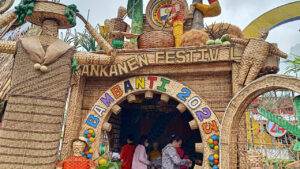Isabela’s Bambanti Festival returns
After a 10-hour drive from Manila to Ilagan City in Isabela, a trip that has visitors surrounded by view of the province’s agricultural nature, they get a confirmation of the area’s bounty. Upon arrival to the city capitol on a chilly Wednesday morning, we found ourselves surrounded by booths filled with food and other products, […]

After a 10-hour drive from Manila to Ilagan City in Isabela, a trip that has visitors surrounded by view of the province’s agricultural nature, they get a confirmation of the area’s bounty. Upon arrival to the city capitol on a chilly Wednesday morning, we found ourselves surrounded by booths filled with food and other products, and locals excited to experience the comeback of the province’s Bambanti Festival.
After a lapse of two years due to the coronavirus pandemic, the Bambanti Festival in Isabela returned to onsite activities from Jan. 20 to 28. This year’s festival theme was “Isabela, Pagharap sa Bagong Hamon ng Kinabukasan” (Isabella: Facing the New Challenges of the Future).
The Bambanti Festival (“bambanti” is the Ilocano word for “scarecrow”) was introduced in 1997 during the term of then-governor Benjamin Dy, and the first festivals were held in May, the province’s founding month. Faustino “Bojie” G. Dy III, who assumed the governorship in 2011 and is the current vice-governor, drafted the resolution that moved the festival to January.
Isabela, located in Luzon’s Cagayan Valley, at 12,414 sq kilometers, is the country’s second largest province. It is known for its agriculture and is considered the corn capital of the Philippines, so the Bambanti Festival is a celebration of the previous year’s harvest. The annual festival aims to foster unity among the province’s residents, promote and preserve its cultural heritage, and promote it’s local products and industries.
Amidst the occasional rain and the chilly January weather, the province celebrated the return of the festival with a beauty pageant, a cooking contest, and street dance competitions, held amongst agri-ecotourism booths from the provinces’ towns and cities which sold local products. Preparation for this year’s festival began as early as June 2022.
Since 2020, the festival’s contests saw the 31 participating towns and cities divided into two categories, A and B. This was done upon the request of the local government units, Isabela vice-governor Mr. Dy told BusinessWorld on the sidelines of the festivities, explaining that having two categories gave the opportunity for more contingents to win cash prizes which would be allocated to the winning city or municipality’s projects.
THE CONTESTS
The first contest on Jan. 25 was the Queen Isabela pageant which became part of the festival in 2020. After holding the titled for three years (thanks to the pandemic), Roseann Camille Fernandez of the municipality of Quirino passed the crown on to Catherine Joy L. Legaspi from the municipality of San Manuel. Assuming nothing forces the cancelation of the festival again, Ms. Legaspi will wear the crown for a year, relinquishing it to the next beauty in 2024.
The beauty pageant was followed by the Makan Ken Mainum (Food and Drink) contest, an initiative of the vice-governor’s wife, Mary Ann Arcega-Dy. The tilt — in which participants explore their creativity in preparing dishes using ingredients and produce from their own towns — is considered the highlight of the festival.
This year’s Makan Ken Mainum welcomed younger contestants — ages nine to 14. Tourism officers from each of the participating contingents took charge in selecting participants from the various schools. The children underwent short culinary courses and were supervised by a cooking coach for their competition recipe.
“It is aimed to discover signature dishes and beverages of the Isabeleños na puwede natin ipagmalaki sa ating probinsya (which our province can be proud of) — not only in Isabela but in the entire country,” Ms. Arcega-Dy said during the opening speech at the contest on Jan. 26.
The competition’s judge, Cornelio “Cocoy” Ventura III, a chef who is a native of Isabela, noted that “after the pandemic, people just want to be expressive and they have been waiting for this time to be out and about especially the kids who have been stuck [at home]… this is their time to show what they can do and also pursue something that is exciting apart from being on their phones and being in school.”
Speaking to the press after the contest, Mr. Ventura said, “Children have very wild and great imagination. I give kudos to those kids for being so creative.”
The cooking tilt’s first prize was awarded to the city of Santiago’s Binalkot a baboy and chicken sinaba — wrapped pork and chicken in a banana leaf vessel. The municipality of Tumauini’s multi-layered drink with flower extracts won Best Drink.
As a way of keeping record, Ms. Arcega-Dy is spearheading the publication of a cookbook of the winning recipes from the last seven years of the festival.
STREET DANCING
As in other festivals around the country, a highlight of Bambanti is the street dance competition and dance showdown. This year, 20 contingents — divided into Category A and B — paraded in colorful scarecrow costumes and performed three-minute dance sequences about their area’s popular myths, industry, or pandemic resilience.
The city of Cauayan (Category A) and municipality of San Agustin (Category B) bagged the first prizes for Best Street Dance Contingent, while the municipalities of Echague (Category A) and Quirino (Category B) bagged the first prizes for the Best Streetdance Showdown Contingent.
The various booths in The Bambanti Village also received awards. The designs of the booths, which displayed each town and city’s local produce, were inspired by the industries and local produce of each area. First prize for Best Agri-ecotourism booth went to the futuristic booth of Ilagan City (Category A) and the fairytale forest themed booth of the municipality of Cordon (Category B).
The various towns and municipalities also set up giant scarecrow installations, and the municipalities of Dinapigue won in Category A for its giant beauty queen figure made of the dried fish sapsap holding a crown, while Cabatuan took the prize in Category B for its giant scarecrow made of abaca and rattan.
The municipality of Quirino was named the festival’s overall champion for 2023 and won P1 million worth of projects. The municipality of San Agustin followed as the first runner-up, receiving P750,000 worth of projects. Second runner-up was a tie between the municipality of Alicia and the City of Ilagan which both received P250,000 worth of projects. — Michelle Anne P. Soliman























